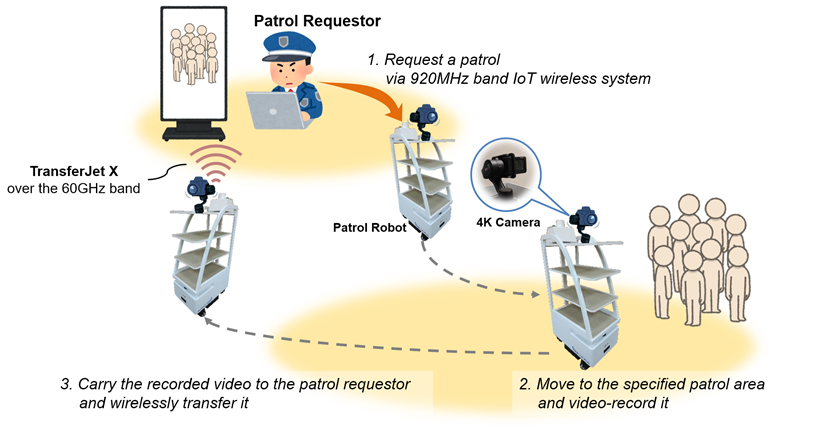The Social ICT Systems Laboratory of the National Institute of Information and Communications (NICT), in collaboration with Sony Semiconductor Solutions Corporation, has developed a collaborative patrol system using autonomous mobile service robots equipped with next-generation, 60 GHz millimeter wave (mmWave) TransferJet communication technology (TransferJet X). TransferJet X is based on the International Standard IEEE 802.15.3e. It is a short-range high-speed wireless communication technology that uses mmWave of 60 GHz band, which does not require a radio station license. Its connection time is 2 ms or less, and a maximum communication speed of 13.1 Gbps can be achieved. The laboratory aims to develop a new solution service using service robots, whose primary jobs are cleaning and delivery and related tasks, to patrol buildings, such as offices, hotels, hospitals, stations, and commercial facilities.
In the security field, fixed-camera systems for crime prevention are already widespread. If these systems can be replaced with higher-resolution ones and if the number of installation locations can be increased for networking, more detailed and advanced analysis results of situations can be obtained from a remote location, such as a control room. There are, however, cases where a broadband communication network is not available or newly installing the infrastructure is costly or physically difficult.
In response to this issue, the laboratory and Sony Semiconductor Solutions Corporation jointly developed a collaborative patrol system that combines such service robots with TransferJet X, paying attention to the rapid development of service robots in various industries that are expected to play an active role in buildings such as offices, hotels, hospitals, stations, and commercial facilities. In this system, a client first sends a request for patrolling a specific area to available service robots equipped with 4K cameras, using an IoT wireless device over the unlicensed 920 MHz band. After the request is received, a robot in the vicinity of the area to be patrolled moves there and records a video of it. The robot then carries the recorded video data to the client, and the data is wirelessly transmitted to the playback device of the client by the millimeter-wave IoT wireless device (developed by Sony Semiconductor Solutions Corporation) using 60GHz-based TransferJet X technology. Finally, the data is automatically played back at the client side.

Credit: National Institute of Information and Communications Technology (NICT)
In the demonstrative trial, it took no more than 163 s (travel time 129 s + data-transmission time 34 s) for a robot with a maximum movement speed of 0.8 m/s to deliver the recorded video data of about 1 min duration (approximately 10 GB) from the patrol location to the client (located 86.8 m away), and to complete the data transfer using TransferJet X. When this result is converted into data transmission throughput, it is equivalent to 514 Mbps (obtained by dividing the data size by the time needed to complete the transfer of the recorded data to the client). This speed is comparable to 480 Mbps, the maximum device-to-device throughput according to the technical standard of the 5th-generation mobile communication system (5G), which is available as a commercial service in Japan as of June 1.
The system can be used as an effective method of wirelessly transferring video data captured by a high-resolution camera, even in locations where it is difficult to install new broadband communication infrastructure or in areas where radio waves cannot reach. In addition, the system can be expected to be applied to an unmanned monitoring service for detecting cracks in structures due to disasters and aging, as well as a service that provides contactless automatic patrols and alerts for dense office environments required in the "New Normal" era post COVID-19. In the future there are also plans to verify the practicality in actual environments, such as in buildings and public facilities such as stations and commercial facilities.
This article has been translated by JST with permission from The Science News Ltd.(https://sci-news.co.jp/). Unauthorized reproduction of the article and photographs is prohibited.




